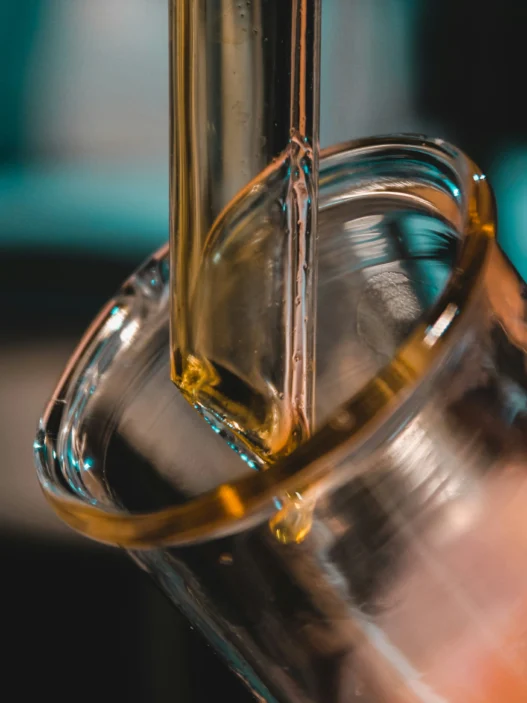Aniline, a toxic organic compound derived from benzene, plays a significant role in everyday life despite its limited use in consumer products. It serves as a crucial precursor in the production of various dyes, pharmaceuticals, rubber chemicals, and pesticides. Additionally, aniline is utilized in the manufacturing of polyurethane foam, used in mattresses, cushions, and insulation materials. Despite its relevance to industrial processes, caution must be exercised when handling aniline due to its toxic properties.
Table of Contents:
- 💡 Commercial Applications
- ⚗️ Chemical & Physical Properties
- 🏭 Production & Procurement
- ⚠️ Safety Considerations
- 🔬 Potential Research Directions
- 🧪 Related Compounds
💡 Commercial Applications
Aniline, a colorless to pale yellow liquid with a distinct odor, finds extensive use in various commercial and industrial applications. It serves as a precursor to a wide range of chemicals, including dyes, pharmaceuticals, and herbicides. The primary use of aniline is in the production of methylene diphenyl diisocyanate (MDI), an essential component in the manufacture of polyurethane foams.
In the realm of drug and medication applications, aniline plays a significant role as a building block for various pharmaceutical products. Aniline derivatives are utilized in the production of analgesics, such as acetaminophen, as well as in the synthesis of certain antibiotics. Additionally, aniline-based compounds are employed in the creation of antimalarial drugs and muscle relaxants, highlighting its versatility in the pharmaceutical industry.
Furthermore, the versatility of aniline extends to its use in the production of rubber additives, antioxidants, and vulcanization accelerators in the rubber industry. Its ability to undergo diverse chemical transformations makes it a valuable raw material for the synthesis of agrochemicals and insecticides. Aniline derivatives are crucial in the formulation of pesticides and fungicides, contributing to agricultural productivity and pest control efforts worldwide.
⚗️ Chemical & Physical Properties
Aniline is a colorless to pale yellow oily liquid with a strong, distinctive odor that is often described as fishy or musty. It is commonly used in the production of dyes, pharmaceuticals, and rubber.
With a molar mass of 93.13 g/mol and a density of 1.022 g/cm³ at room temperature, aniline is heavier than most common household items. For comparison, water has a molar mass of 18.02 g/mol and a density of 1.00 g/cm³.
Aniline has a melting point of -6.0°C and a boiling point of 184.13°C. When compared to common household items, aniline has a lower melting point than water (0°C) and a higher boiling point than many household liquids like rubbing alcohol (78.37°C).
Aniline is sparingly soluble in water, with a solubility of approximately 3 g/L at room temperature. It has a low viscosity, making it flow easily. In comparison, common household items like salt and sugar are highly soluble in water, and have a higher viscosity than aniline.
🏭 Production & Procurement
Aniline is commonly produced through the catalytic hydrogenation of nitrobenzene, a process that involves the reduction of nitrobenzene in the presence of a metal catalyst such as iron or nickel. This reaction results in the formation of aniline, along with water as a byproduct. The resulting aniline can then be separated and purified through processes such as distillation or crystallization.
Aniline can be procured through various means, including direct purchase from chemical suppliers or manufacturers. In addition, aniline can also be synthesized in laboratories using appropriate chemical precursors and equipment. Once obtained, aniline can be transported via various methods such as tanker trucks, railcars, or drums depending on the quantity and distance of transport required. It is important to handle aniline with care due to its toxic properties and potential hazards.
⚠️ Safety Considerations
Safety considerations for Aniline include its potential for skin and eye irritation, as well as its acute toxicity when inhaled or ingested. Aniline may also cause respiratory tract irritation and central nervous system effects if exposure occurs at high levels. Proper ventilation and personal protective equipment, such as gloves and goggles, are essential when working with aniline to minimize these risks.
Aniline, a primary aromatic amine, is a key building block in the production of many dyes, pharmaceuticals, and agricultural chemicals. In the body, aniline is metabolized by cytochrome P450 enzymes to form reactive intermediates that can cause DNA damage and lead to carcinogenesis. Additionally, aniline can cause methemoglobinemia, a condition in which the blood’s ability to carry oxygen is impaired, leading to symptoms such as cyanosis and shortness of breath.
Hazard statements for Aniline include its classification as a skin irritant, eye irritant, and acute toxicity hazard. Aniline is also classified as a suspected human carcinogen based on animal studies showing an increased incidence of tumors following chronic exposure. In case of skin contact, eye contact, or ingestion, immediate medical attention is required to prevent serious health effects.
Precautionary statements for Aniline include the need to wear protective gloves, clothing, and eye protection when handling the substance. It is also important to use aniline in a well-ventilated area to minimize inhalation exposure. In case of a spill, proper clean-up procedures should be followed to prevent environmental contamination and exposure to individuals. Additionally, avoiding mixing aniline with strong oxidizing agents can reduce the risk of fire and explosion hazards.
🔬 Potential Research Directions
One potential research direction for aniline is the development of novel synthesis methods to improve efficiency and sustainability in its production. This could involve exploring new catalytic processes or reaction conditions to reduce waste and increase yield.
Another area of interest could be the study of aniline derivatives and their applications in pharmaceuticals, dyes, and other industries. Understanding the structure-activity relationships of these compounds could lead to the design of new and improved products with enhanced properties.
Furthermore, research into the environmental impact of aniline and its derivatives, as well as methods for remediation of contaminated sites, could provide valuable insights for addressing pollution and ensuring the safe handling and disposal of these chemicals. This area of study is crucial for protecting human health and the environment.
🧪 Related Compounds
One compound similar in molecular structure to Aniline is Phenylamine, also known as Benzenamine. It is an aromatic amine with the chemical formula C6H5NH2. Phenylamine is structurally related to Aniline, as both molecules contain a phenyl ring attached to an amino group. Like Aniline, Phenylamine is used in the production of various chemicals and materials, including dyes and pharmaceuticals.
Another compound with a similar structure to Aniline is N-Methylaniline, which has the molecular formula C7H9N. N-Methylaniline is an aromatic amine in which a methyl group is attached to the amino group of Aniline. This compound exhibits properties similar to Aniline due to the presence of the aromatic ring and amino group in its structure. N-Methylaniline is commonly used as an intermediate in the synthesis of dyes and pharmaceuticals.
A third compound resembling Aniline in molecular structure is Diphenylamine, with the chemical formula (C6H5)2NH. Diphenylamine is an aromatic amine in which two phenyl rings are connected by an amino group. This compound is structurally similar to Aniline, as both molecules contain aromatic rings and amino groups. Diphenylamine is utilized in the manufacture of antioxidants, explosives, and pharmaceuticals due to its chemical properties resembling those of Aniline.





